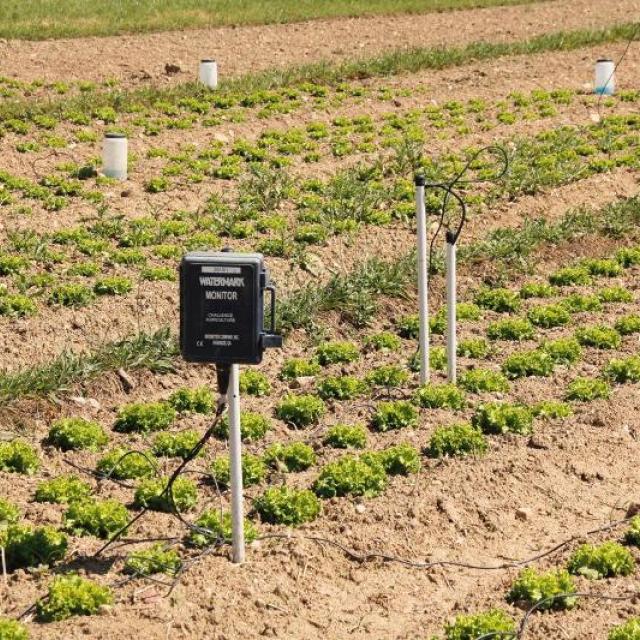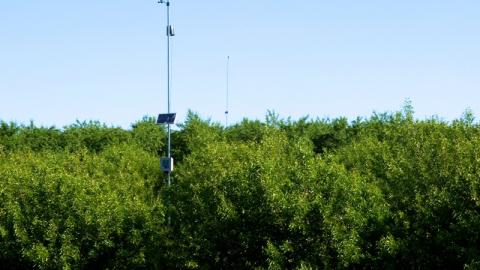As every farmer knows, water is essential for the survival of a crop. In the regions where there is a shortage, irrigation can help to mitigate the effects of the dry periods and provide a certain security vis-à-vis the production.

Nevertheless, as Quevedo said, ‘Anything in excess goes against all reason’ and overirrigating could have certain repercussions for the farm:
- Agronomic impact: reduced yield, loss of quality of the fruit, leaching of the soil;
- Economic losses: labour, losses linked to the cost of the water consumed, conveying the liquid, storage, etc.
The main issue and thus the main difficulty is, therefore, managing the irrigation scheduling correctly in the field; in other words, the following aspects must be addressed: When to irrigate? How much water to apply? How to irrigate?
There are many ways of addressing the subject of scheduling. A number of tools, each with very different objectives and uses, are available to the farmers and need to be analysed beforehand in order to choose the option best suited to the farmer’s needs. This task can be approached in the following way:
|
Accuracy |
Crop |
Irrigation site |
External constraints |
Tools |
||||
|
|
Type of production |
Economic aspect |
Equipment |
Labour required |
Contract |
Water resource |
Pollution |
Objective measurements, tensiometry |
|
Very beneficial |
Intensive |
High cost of water |
Fixed and adequate |
Skilled |
Very stringent terms and conditions |
Very restricted |
Sensitive zone |
|
|
|
|
|
|
|
|
|
|
PEPISTA
|
|
|
|
|
|
|
|
|
|
Water balance
|
|
|
|
|
|
|
|
|
|
Programming
|
|
Useful |
Extensive |
Inexpensive water |
Movable |
Unskilled |
No constraints |
Unlimited |
No risks |
« Bulletins »
|
As shown in the above table, there are a number of different kindsof irrigation scheduling tools, which we will group together here under three main headings:
Technical advice or bulletins
These are provided by the Chamber of Agriculture, technical institutes, agricultural co-operatives or even the manufacturers. Without taking into consideration the actual field conditions, they, nevertheless, enable the farmer to plot an irrigation schedule and thus avoid making any serious mistakes. Example: « After a rainfall of more than 10 mm, delay your irrigation cycle by 1 day for every extra 5 mm of precipitation. » This advice is generally found in the information bulletins or fact sheets. In this case, it is advisable to contact any farm advisory service operating in your area.
Tools available for evaluating the soil water balance
The soil water balance is an equation that considers certain values:
- Precipitation rate
- Volumetric soil water content
- Evapotranspiration
- Amounts of irrigation water applied
These data, when they are reliable, historical and based on frequency analyses, canenable a good level of irrigation scheduling to be applied over many plots.
The farmer can calculate the soil water balance by using the following equation:
Soil water status day n = Soil water status day n-1 + Rainfall + Irrigation – Evapotranspiration
The accuracy required for these values, which is often absent, means the soil water balance method is unsuitable for precision irrigation. It is, however, effective in situations where irrigation requires less vigilance: less expensive water, unskilled labour or unrestricted source of water. Nevertheless, change will come bit by bit and the soil water balance method will become increasingly more sophisticated.
Nowadays, some organisations offer water balance software packages that allow the user to monitor the status of the soil water content on the farm, via a private web portal.The variable to be input manually is basically the irrigation dosage. The other variables are incorporated into the software and calculated according to pre-programmed values. These packages are very useful tools that have become increasingly accurate because of the sharing of weather information and an in-depth knowledge of the soils found in a certain area, allowing not only the monitoring but also, more importantly, the accurate assessment of the soil water status over several days. These are now offered by, among others, certain advisory bodies (Loiret Chamber of Agriculture, NET-IRRIG), technical institutes (Arvalis, IRRE-LIS or Terres Inovia, IRRISOJA) or seed companies (Limagrain, LG VISION).
On-site measurement tools
Given their purchase price and the level of technical monitoring required, they are used exclusively in situations where precision irrigation is not only required but almost essential: high cost of water, intensive production, limited water resources, skilled labour. The measurements are made in the soil to ascertain its moisture content or soil moisture tension, or directly on the crop to determine the presence of harmful plant water stress.
In no particular order, the measuring devices mostly used are:
Tensiometer probes
These measure the soil water potential, i.e. the attractive forces between the water and soil particles. The forces increase when the soil dries out because all the gravitational and readily available water has been consumed. The tensiometer probes consist of a tube filled with water and a porous ceramic cup that is in contact with the soil. The water in the tube, which is in equilibrium with the water in the soil, creates a vacuum in the tube which can be measured with a vacuum gauge, mercury manometer or pressure sensor. The readings taken for this vacuum are then used to provide an indication of the soil water potential.
These probes are practical because they can be installed relatively quickly and are inexpensive and easy to maintain. On the other hand, they are not very accurate beyond a certain level of soil water potential (100 centibar), the tube must be frequently filled with water and someone must go to the site to take the readings.
Granular matrix sensors
Promoted by Irrometer (Watermark® sensors), these probes measure the electrical resistance of a porous matrix (sand and gypsum provide some buffering for salinity levels) via two electrodes buried in the soil, in equilibrium with the water in the soil. The electrical resistance, therefore, reflects the soil water potential. These sensors can be linked by batteries connected to a data logger. Thus, several points of measurement are installed in the field for greater representation. The cost of using independent probes is low but it becomes higher when a data logger is included.
Furthermore, the data logged can be transmitted remotely by GPS and collected on a web-based platform so as to be able to consult the soil moisture status easily and 24/7. This remote transmission can also be used for the automation of the irrigation system with electro-valves controlled by a mobile phone, controlled on the basis of the soil water potential values (e.g. open the valves for 1 hour as soon as the 50 centibar threshold is exceeded).
The problem with these probes, which are very popular with the professionals, is that they are not very accurate at low tension levels (saturated soils) and they do not respond very well to sudden variations in the soil water potential. They do, however, still act as a point of reference in irrigation scheduling.
Capacitance probes
These measure the soil water content without having to resort to the traditional direct method (drying out soil samples at 105° C). Sensors situated at different depths send out electrical signals and the soil moisture content can be determined by changes in the circuit operating frequency, as water is a good conductor of electricity. The dielectric permittivity of the soil medium is influenced by the level of salinity and soil structure, so a calibration scale is required.
The recorded measurements can be transmitted remotely and uploaded to a web-based interface to be made available throughout the irrigation season or crop year. Certain capacitive probes use lithium battery packs, which can guarantee their operation for several years without the need to recharge, making it a practical and long-lasting device. There are many brands on the market, such as Sentek, Corhize, Hortau and even John Deere.
The PEPISTA system
Mainly used in orchards and vineyards, the PEPISTA probes are known as « dendrometers » because they measure the daily growthof the diameter of the branch and/or trunk of the fruit tree in hundredths of mm. The growth can be categorised into two types: the difference in diameter over two days (net growth) and the scale of contraction (loss of diameter) during the day. This growth pattern, which can fluctuate or even stop (when the rate of shrinkage is greater than the net growth) can be directly related to plant water stress. The whole assembly consists of an electronic control unit recording on an hourly basis the data transmitted by the sensors on the plant. The PEPISTA® measurements must, nevertheless, be used in conjunction with the data taken from the soil measurements in order to have a more complete picture.
There are other kinds of probes in existence but they are rarely seen on the farms of today: TDR probes (Time Domain Reflectometry), neutron moisture gauges, gypsum blocks, etc. and they are often only found in the field of research and experimentation.
In order to adopt a sound approach to the issues of irrigation scheduling, it is important to identify and respond to the needs and requirements of the farm before choosing such and such device. The most expensive or latest product is not necessarily the most efficient and, in fact, it may not be suitable for the type of scheduling that you want to achieve. As different devices measure different values, it is essential to gather as much information as possible in order to have an optimum irrigation management system on the farm. It must be repeated that the optimum will differ according to the type of crop, plant water requirements and the specific agricultural context.

